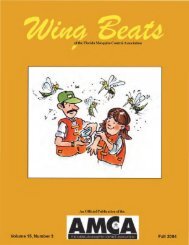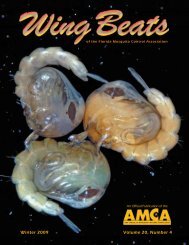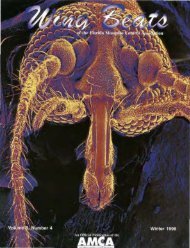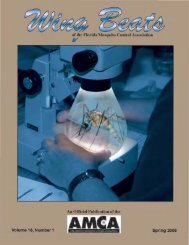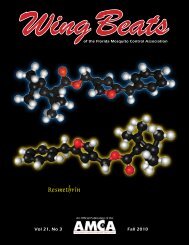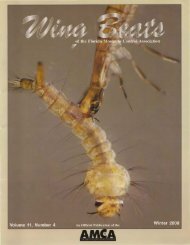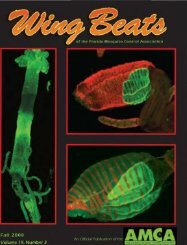Volume 23 Number 1 - Wing Beats - Wing Beats - Florida Mosquito ...
Volume 23 Number 1 - Wing Beats - Wing Beats - Florida Mosquito ...
Volume 23 Number 1 - Wing Beats - Wing Beats - Florida Mosquito ...
Create successful ePaper yourself
Turn your PDF publications into a flip-book with our unique Google optimized e-Paper software.
34<br />
larvae were sometimes observed<br />
when fish were in a pool.<br />
4. Floating algal mats; see Figure<br />
8. Dense mats of filamentous<br />
algae were most prominent in<br />
the summer, sometimes almost<br />
completely covering a pool. The<br />
clear water, shaded by the mats,<br />
supported few mosquito larvae<br />
even in the absence of fish. Backswimmers<br />
and diving beetles were<br />
often common if fish were not<br />
present. Fish thrived in this ecotype,<br />
and mosquito larvae were<br />
virtually absent if fish were present.<br />
Why were fish missing from 14%<br />
of the pools to which they were<br />
introduced in 2006? Some of<br />
the introductions during 2006<br />
simply failed to take hold in the<br />
first place. Dumping bleach was<br />
counterproductive, and draining<br />
pools could wipe out the fish, but<br />
this was not happening on a scale<br />
to explain so many pools without<br />
fish. While some pools were probably<br />
too polluted in 2006 for fish<br />
to survive, we concluded that the<br />
main problem was trauma during<br />
transport from holding tank to<br />
pool. The pace was intense, and<br />
the fish sometimes appeared in<br />
poor condition (swimming at a<br />
slant and moving erratically) when<br />
poured from the plastic bag into<br />
a pool, particularly if it was hot<br />
and they had been in the bag for<br />
the entire day. The success rate<br />
of Gambusia introductions during<br />
2006 improved with experience.<br />
While 84% percent of the pools<br />
to which fish were introduced<br />
during the first two months of the<br />
program still had fish when next inspected,<br />
this measure of success<br />
increased month by month to<br />
95% for pools receiving introductions<br />
late in the year. By 2007-2008<br />
the pollution had declined significantly,<br />
and the smaller number of<br />
introductions at that time allowed<br />
more careful attention to the<br />
fish, including rapid transport to<br />
pools. Every monitored Gambusia<br />
Spring 2012 <strong>Wing</strong> <strong>Beats</strong><br />
Figure 8: The “floating algal mats” ecotype supported few mosquito<br />
larvae. Fish thrived when introduced to this ecotype.<br />
introduction during 2007-2008 led<br />
to a thriving population within a<br />
month – an introduction success<br />
rate of 100% – and the population<br />
in every pool lasted for as long as<br />
the pool contained water.<br />
Experience with the swimming<br />
pools taught us some lessons<br />
that could be of use to others for<br />
disaster readiness planning. For<br />
example, it is best to line up a<br />
reliable source of fish in advance.<br />
It took us several months<br />
to track down a supply for such<br />
large-scale use.<br />
We also used larvicides, mainly<br />
VectoLex, to suppress mosquito<br />
production until the fish took over.<br />
VectoLex does not kill Anopheles<br />
larvae but is known for its effectiveness<br />
and residual capacity<br />
against Culex. We could count<br />
on a single VectoLex application<br />
to kill all the Culex and Culiseta<br />
larvae in a swimming pool within<br />
a day or two. However, the residual<br />
period in such deep water<br />
was limited because Bacillus<br />
sphaericus eventually sank to<br />
the bottom while the mosquito<br />
larvae fed mainly at the top. We<br />
found that VectoLex reliably killed<br />
all new larvae for only a few days<br />
after application, though complete<br />
kill extended for as much<br />
as 10 days in pools with heavy<br />
organic loading.<br />
Locating swimming pools was<br />
a challenge when searching<br />
through a hundred thousand<br />
houses in a city devoid of residents<br />
over areas extending<br />
for miles. The Pictometry aerial<br />
photo system, Google Earth,<br />
and real estate listing records<br />
proved invaluable for tabulating<br />
the addresses of houses with<br />
pools. Up-to-date photos showed<br />
whether pools were maintained.<br />
Cleaning trash out of pools was<br />
basic habitat management because<br />
organic detritus fueled<br />
the food web leading to mosquito<br />
larvae. Putrid conditions,<br />
which could last for more than a<br />
year if not corrected, were ideal<br />
for Culex larvae and stressful for<br />
fish. Trash of any kind provided<br />
refuge for Anopheles larvae to<br />
evade predators.



